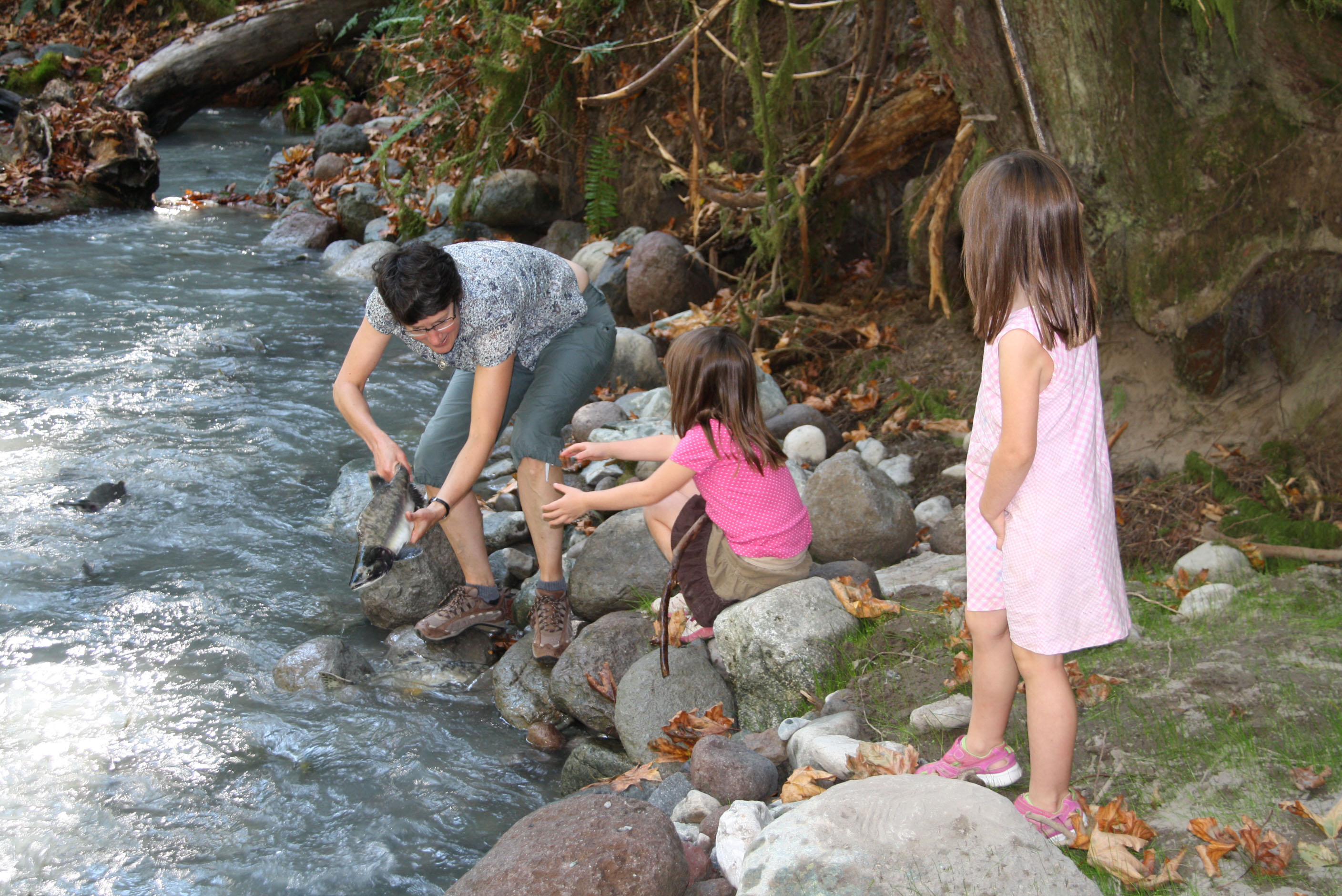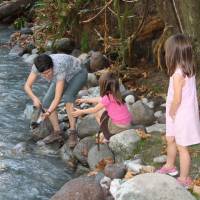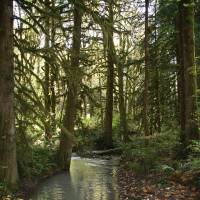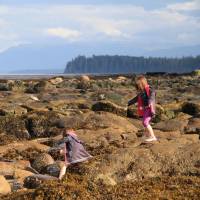It was really good to escape the summer heat in Japan and spend two weeks in British Columbia with three of my grown offspring and five grandchildren, as well as with lots of friends both old and new.
Although I love Japan, and am very proud to be a Japanese citizen, things about this country have — especially since the Great East Japan Earthquake and tsunami in March 2011, and the terrible and ongoing nuclear fiasco of Fukushima — been getting me down, and the seeds of depression and desperation were starting to take root.
So what better antidote could I have had than to fly to Vancouver and head off into the boundless natural wonder of Canada's westernmost province — one whose name was chosen by Queen Victoria in 1858.
There, under huge Pacific skies, I was able to marvel at hummingbirds hovering and darting around the liquid-sugar feeder by my eldest daughter's back window; watch seals basking on rocks just 100 meters from the seafront window of a friend's house; delight in seeing bears with their fur so glossy and black; gaze up at soaring eagles; be entertained by hooting and honking ravens; and wonder as ever as tens of thousands of salmon made their one-way trip from the ocean up spawning streams to lay and fertilize their eggs.
All that, and of course I also got to see and hear so many youngsters, including my own grandchildren, playing and discovering that wonderful world of nature.
However, despite British Columbia's motto — "Splendor sine occasu" ("Splendor without diminishment") — being so fitting in many ways, there are serious environmental problems facing Canada, including attempts by the present administration to force through the oft-postponed Enbridge Northern Gateway Pipelines Project.
This proposal first made around 10 years ago by Enbridge Inc., a Canadian crude oil and liquids pipeline company, would see twin pipelines run 1,177 km through pristine mountain, river and forest territory between Alberta and a marine terminal near Kitimat, British Columbia. Not only that, but to and from Kitimat supertankers would have to ply the beautiful but treacherous Hecate Straits — considered the fourth most dangerous commercial waterway in the world — to import natural gas and export oil to Asia.
The plan is vehemently opposed by environmentalists and conservationists, and also by the majority of the First Nations peoples. Yet as I heard many of my family and dear friends, including writer and Afghan War veteran Trevor Greene, speak out strongly against this project, I realized they were entertaining none of the dark apathy and quiet despair I now constantly face in Japan.
Following the March 2011 catastrophes, the major themes for Japan should have been recovery and restoration. Instead we have procrastination, endless excuses, more waste and a ridiculous plan to build what I call the Great Sea Wall of Japan. All that and more combined with an ever-increasing distance between children and nature. So you see: I really needed to get away for a while.
Don McCubbing, my oldest daughter's partner and the father of my twin granddaughters, is a Scottish-born fisheries biologist and president of North Vancouver-based InStream Fisheries Research Inc. Don restores and monitors the restoration of streams and rivers to sustainable natural productivity.
In other words, he brings trout and salmon and the whole wondrous web of interrelating nature back to waterways ruined by foolish construction, excess logging, pollution and other wanton acts of humanity.
One of the projects Don monitors is at the North Vancouver Outdoor School in Paradise Valley, just outside the town of Squamish about halfway between North Vancouver and the ski resort of Whistler. NVOS was founded in 1969 in a beautiful area of forest beside the swift, glacier-fed Cheakamus River. However, in order to protect a railroad and other installations, the river had been artificially channeled, thus removing its natural braiding and habitat complexity and hence reducing its capacity for spawning salmon.
To counteract these depredations, 11 years ago spawning channels and loops were cut through the woods now used by the school. As they were very successful for the salmon and their fry, more were added to create what is now 24,500 sq. meters of spawning habitat and 58,000 sq. meters of salmonid-raising habitat.
When I visited the outdoor school and their woods in August, a new section of channel had just been opened and within 30 minutes it was full of spawning pink salmon (Oncorhynchus gorbuscha — karafuto masu or seppari masu in Japanese). I was told that chum salmon (O. keta — shirozake in Japanese) as well as the larger coho salmon (O. kisutch — ginzake in Japanese) would soon follow.
The channels are 2 or 3 meters wide, and they're shallow with mostly gravel bottoms and rocky sides. In places, gravel and rocks were added; elsewhere they were naturally occurring. Apart from the river water, cold groundwater adds to the habitat, which is further enhanced by logs and root wads to give the small fish places to hide. Backwaters for raising small fish have also been created.
Footpaths run by the streams and small bridges cross them, and the whole area is a home for bears, eagles and other wildlife — and a wonderful place to educate children. A crucial facet of this is the close involvement of the Squamish First Nations peoples in those education programs, so children can learn about life before the encroachment of modern civilization — thus furthering their appreciation and understanding of nature and of different cultures.
We are hoping to forge links between NVOS and our Afan Woodland Trust here in the hills of Nagano Prefecture so as to exchange students, expertise and enthusiasm.
After meeting and talking with people at the outdoor school, my family drove me up to Port Hardy in the north of Vancouver Island, where Don's company has been monitoring salmon on the Keogh River. The Keogh was badly damaged by poor logging practices that led to flash floods and a decline in salmon and trout habitat.
Now, though, thanks to an extensive program of wiser forestry practices and habitat restoration — with hardly any use of concrete — the river has recovered. Pink, coho and chum salmon have come back in numbers and are now thriving again in the river along with steelhead trout (O. mykiss) — sea-run rainbow trout that return to spawn in their native rivers; Dolly Varden trout (Salvelinus malma malma), a variety of char; and cutthroat trout (O. clarkii), a freshwater salmonid. With the return of the salmon the bears, otters, cougars, wolves, eagles and other wildlife have also come back. It was a joy to see.
This year there was an exceptional run of fine, sunny weather in northern Vancouver Island, so the Keogh River was low, and when I was there the pinks and the cohos were massing at the entrance of the river, which at low tide runs over seaweed-covered rocks and little rocky waterfalls. The gulls, seals, eagles and ravens were having a grand old time!
The day we left to return to Vancouver it rained, and the salmon were going over the fish-counter weirs on the Keogh River at a rate of scores every second. I have worked with and been around fisheries for a long time, but I have never seen so many salmon as I saw this year in British Columbia. In fact, Don told me that this year about 26 million pink salmon were expected in the 1,375-km Fraser River that rises in the Rockies and flows into the Pacific at Vancouver.
I grieve when I think how there were thousands of salmon rivers in Japan, from northern Kyushu to Hokkaido — but almost all of them have been ruined by pollution, dams and concrete. If Japan ever woke up and put its boundless energy to nature restoration, this country could be a very special place indeed.
For this old bear that would mean far, far more than another Olympics — and it would make much better sense than the hideous, expensive and mostly meaningless Great Sea Wall of Japan that's planned.





















With your current subscription plan you can comment on stories. However, before writing your first comment, please create a display name in the Profile section of your subscriber account page.